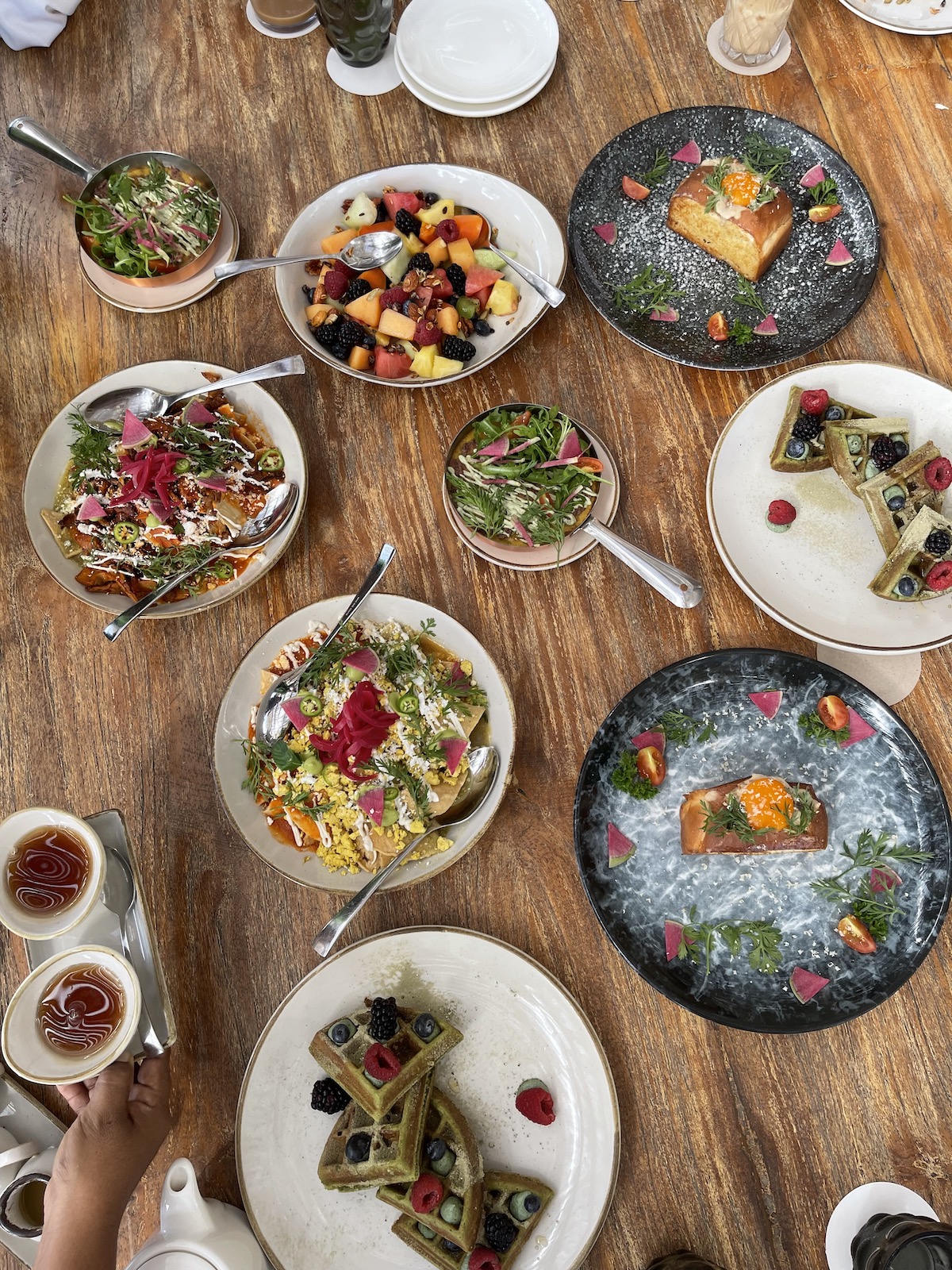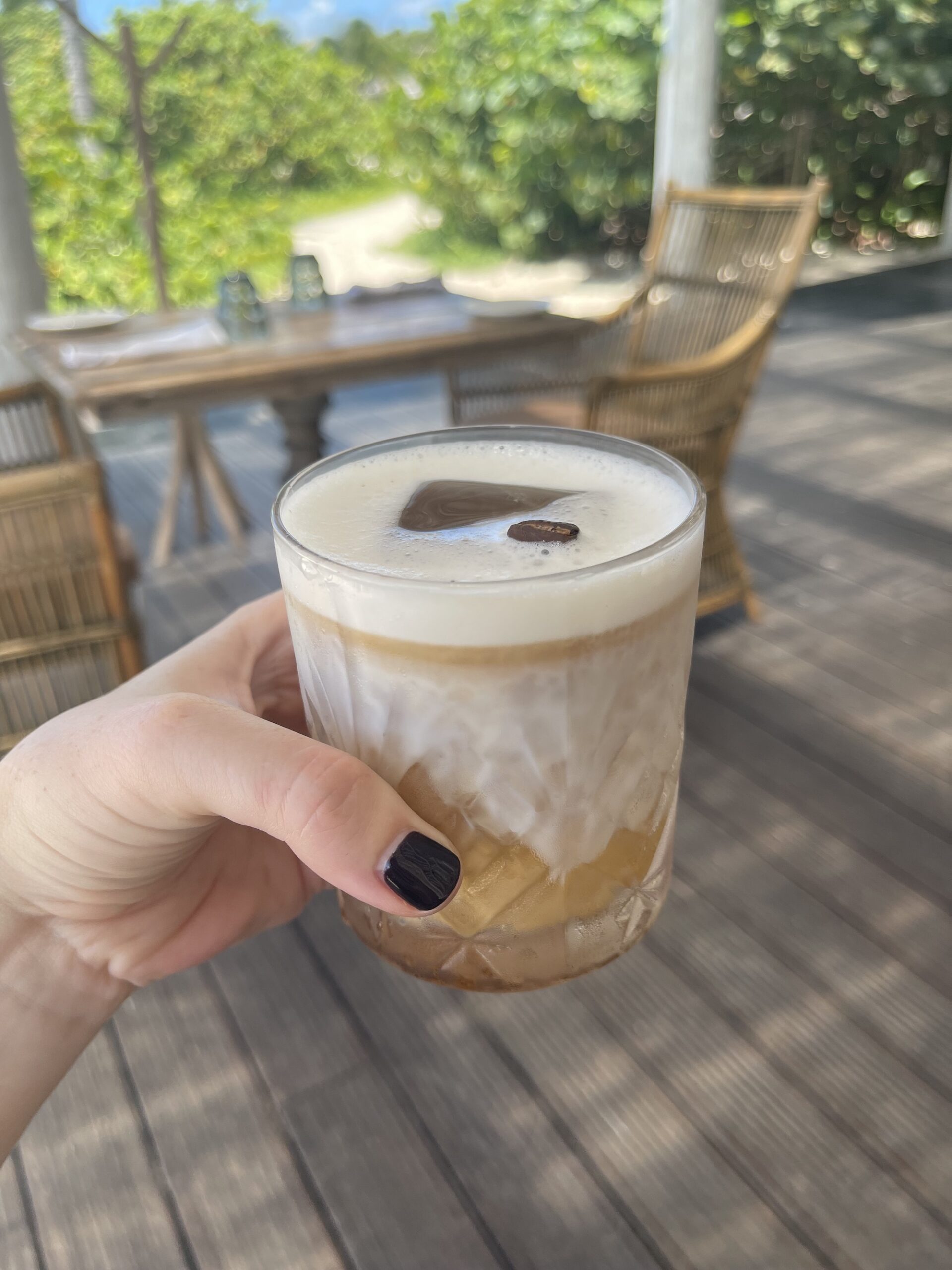It doesn’t help that most hotels and resorts tend to have menus that aren’t exactly gut-friendly. One of my favorite things in the world is munching on a plate of salty poolside snacks and catching up on my reading list under a beach umbrella—but when I haven’t pooped for three days, meals that are meant to be joyful become a source of stress and anxiety. Not fun!
There are a lot of reasons why so many of us grapple with tummy problems while on vacation. The first one is that the act of traveling itself is pretty hard on our bodies, especially our guts. “When you sit for a long period of time or you’re immobile, your intestinal motility decreases, which means the gas that’s in your bowels is kept in your bowels and you don’t pass it,” board-certified gastroenterologist Niket Sonpal, MD, FACP, DABIM, previously told us.
The general physics of airplane travel do us dirty, too. “Low pressure during the flight due to high altitude can cause gas and bloating,” Ali Rezaie, MD, gastroenterologist from the Good LFE team, explains.
The second major issue is that our normal routines have been disrupted—which can it take a toll on our bowel movements. “Often on vacation, people may not follow the same routines they do at home. They may not take the same supplements, drink the same warm beverages, or sit for 15 minutes scrolling on their phone as they sip tea or coffee. These seemingly insignificant patterns set the body up on a schedule for consistent bowel movements,” Caroline Cederquist, MD, a board certified physician, tells W+G.
Which is why my stay at wellness resort Palmaïa in Cancun, Mexico last summer was such an illuminating experience that taught me it’s actually very possible to travel and still maintain a happy, healthy gut.
A little about Palmaïa
Palmaïa, which opened its doors in 2020, is the type of wellness sanctuary that transcends relaxation: It rewires your entire body from the inside out. The oceanfront resort, located in the lush Riviera Maya region of Cancun, Mexico, is completely secluded, its suites and villas surrounded by lush, jungle greenery, infinity pools, and freshwater cenotes (flooded caves). As you stroll down the many paths to its restaurants and spas, you’re likely to pass by monkeys and iguanas perched on their branches. Basically? It’s paradise.

The resort prides itself on many of its unique offerings, but my favorite was its dedication to a holistic culinary experience: It’s what made me completely rethink travel, food, and gut health.
The resort prides itself on many of its unique offerings, but my favorite was its dedication to a holistic culinary experience: It’s what made me completely rethink travel, food, and gut health.
Palmaïa’s gourmet restaurants, all led by Michelin-trained chefs, have a single goal in mind: Nourish (not just feed!) its patrons with thoughtful and delicious meals. Most of the menus are completely plant-based (non-vegan options are available, too), focusing on quality, taste, and nutrients that leave bodies radically energized.
Through food, Palmaïa wants you to feel good—which is why its menus are crafted with gut-enriching ingredients travelers like me desperately need.
I had the experience of getting lunch with Christine Weiss, the property’s holistic nutritionist who consults with the resort’s Executive Chef, Carlos Carrion Garcia (aka Chef Charly), and she explained to me why it was so important that Palmaïa’s many menus emphasized gut-healthy offerings. “A healthy gut is crucial for feeling good. If our gut is unhappy, we are unhappy. Any kind of digestive issue—constipation, diarrhea or bloating—influences the quality of life immensely,” Weiss said. “And by eating a healthy and balanced diet that is rich in probiotic and prebiotic foods, we help our gut to feel good.” Studies show that the most effective way to enhance the health of your gut microbiome is to eat a wide variety of plant-based foods, which is exactly was Palmaia’s dining options have to offer—from vegan sushi (made with ingredients like mushrooms, micro-greens, and the most delicious sauces I’ve ever tasted), to veggie-rich flatbreads, I was lucky enough to sample a large chunk of the menus.
What I ate during my stay at Palmaïa
What did not eat at Palmaïa might be the more apt question. I was lucky to be able to sample dishes from all of the property’s restaurants. Guests can choose from four establishments: Lek (Mexican), Ume (Japanese-inspired), Mar de Olivo (Mediterranean-inspired), and Su Casa (a sampling of various cuisines from around the globe, and also home to the best matcha pancakes I’d ever tried). Plus, there’s the El Caminante food truck, which is Chef Charly’s “satellite” taco truck, whose original (and massively popular) headquarters are located in Tulum. It was the most well-fed I’d ever been on a vacation—and the best I had ever felt. Weiss had told me that, “Guests staying at Palmaïa not only feel good during their stay, they also feel nourished, full of energy, their digestion improves and they get mental clarity.” And it was certainly true for me.
On the day I had lunch with Weiss, she had the chefs bring out a curation of fermented sides: a few different types of sauerkraut and kimchi. I tried a bit of each (a traditional sauerkraut, “sunnykraut,” which was made with pineapple, turmeric, and ginger, and ginger apple spice kraut, which had apples, nutmeg, and ginger), along with my plant-based burger and fries (halfway through my burger, I completely forgot I wasn’t eating a meat patty). Poolside eats generally make me want to take a nap, but at Palmaïa, I felt awake, alert, and game for anything.

Needless to say: I didn’t experience any of the gut issues I normally would have on vacation anywhere else. My bathroom “excursions” were…normal. I wasn’t stressed about bloating, constipation, or that very specific degree of panic you feel when you absolutely must find a toilet at the worst moment in time.
That was thanks to the many GI-enriching ingredients in the meals I ate at the resort, like the homemade yogurt, and its fiber-rich mains and sides. “Our homemade coconut yogurt contains probiotic yoghurt-cultures which makes it also an excellent food for gut health. All the foods are high in fiber are very beneficial for a healthy microbiome, including all the legumes—beans, chickpeas, peas, lentils—and vegetables, especially cruciferous vegetables. These are all foods we use very generously for all the meals we serve,” Weiss explained.

Jill Carnahan, MD, author of Unexpected, agrees with this culinary approach, telling Well+Good, “Fermented foods naturally contain high levels of beneficial bacteria that serve as probiotics to regulate bowels and protect the gut from foreign microorganisms. Many local cultures make and serve probiotic foods, such as kombucha, miso, kimchi, sauerkraut, kefir or yogurts as part of their rich heritage and these foods can serve to nourish and protect the gut while traveling.”
One more hot tip: Palmaïa serves an incredible cold brew. While I generally use coffee as a last-resort way to get my gears going while on vacation, I leisurely sipped on Su Casa’s cold brew with oat milk throughout my entire trip (even by the pool, away from my room with the bathroom inside—brave for me), feeling the caffeine energize me without the jitters, and, yes, continue to keep me “regular.” Not that I needed help in that department—I just wasn’t sprinting to the nearest toilet after finishing a glass.

Dr. Carnahan is also pro-coffee, if your stomach can normally handle it. “Coffee is often given a bad rap but unless you are hypersensitive to the caffeine itself, it is a very rich source of polyphenols and antioxidants, protecting and nourishing the gut bacteria. Brewing fresh local coffee beans is actually a rich source of fuel for your gut microbes to create short chain fatty acids (SCFAs) like butyrate, which nourish the cells that line your gut and aid in digestion and decrease inflammation.”
“I think organic, locally sourced fresh coffee in moderation is an excellent addition for the savvy traveler.”—Dr. Carnahan
In addition, according to Dr. Carnahan, coffee is a gentle stimulant that may help regain regularity of bowels when you travel across time zones and signal the body to reset the circadian rhythm. “I think organic, locally-sourced fresh coffee in moderation is an excellent addition for the savvy traveler,” Dr. Carnahan says.
How to make your own Palmaïa sauerkraut at home
I’m not traveling anytime soon, but I will be making one of Palmaïa’s beloved fermented snacks at home. It takes me back to one of my favorite places and my gut absolutely love it. Weiss shares the resort’s top-ordered sauerkraut with W+G here:
Sunnykraut
Serves 15
Ingredients
1 medium-sized cabbage head
1/2 fresh pineapple
1/2 cup fresh turmeric
1/2 cup fresh ginger
1 Tbs sea salt
1 Tbs apple cider vinegar
Instructions
1. Clean the cabbage, remove the outer leaves and set three to four big leaves aside. Cut the cabbage head into quarters. Remove the central trunk and cut the cabbage into thin strips or use a food processor or mandolin. Chop the pineapple and grate the turmeric and ginger finely (wear gloves as the turmeric juice will stain your hands).
2. Put the cabbage and pineapple in a wide glass or steel bowl and add the salt, spices and vinegar. With very clean hands massage the cabbage for at least 10 minutes, so that the salt reaches all the cabbage and it releases its juices. Continue with massaging until the cabbage is completely covered with enough liquid. Let it sit for 30 minutes to give it time to continue to macerate and release more juices.
3. Transfer the cabbage into a very clean glass jar by squeezing out all the liquid. Put the cabbage in first and press it all the way down to the bottom of the jar with your hands. Then add the produced liquid carefully on top of it. Place in the leaves you set aside on the cabbage and push it down under the brine. Put a plastic bag filled with water on top of the cabbage leaves so that the cabbage is completely submerged in the brine. Leave about one to two inches of space form the top of the jar. Cover it with a kitchen towel or screw on the lid loosely so gas can escape as the fermentation takes place.
4. Set the jar on the counter in a shaded place, ideally around 68° F. Leave it there until it has reached its final flavor. In a few hours you begin to see CO2 bubbles rising to the surface. This is perfectly normal.
5. As the days go by, the cabbage becomes more tender and the flavor more acidic. After five to six days, the sauerkraut is crunchy and deliciously fresh. After about 10 days the flavor gets a little tarter and the texture softer. After about two weeks it should have the perfect flavor and texture. Remove the big cabbage leaves and the bag filled with water, screw on the lid properly and put the jar in the fridge.
For more information about Palmaïa’s accommodations and pricing, visit their website here. You can also book your entire trip through Expedia.
Our editors independently select these products. Making a purchase through our links may earn Well+Good a commission.
